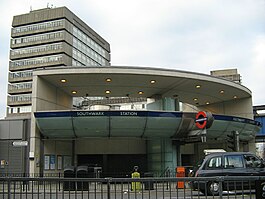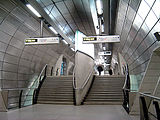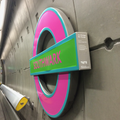Southwark tube station
| Southwark | |
|---|---|
 Entrance on The Cut | |
| Location | Bankside |
| Local authority | London Borough of Southwark |
| Managed by | London Underground |
| Number of platforms | 2 |
| Accessible | Yes[1] |
| Fare zone | 1 |
| OSI | Waterloo East Blackfriars at Bankside entrance |
| London Underground annual entry and exit | |
| 2018 | |
| 2019 | |
| 2020 | |
| 2021 | |
| 2022 | |
| Railway companies | |
| Original company | London Regional Transport |
| Key dates | |
| 20 November 1999 | Opened |
| Other information | |
| External links | |
| WGS84 | 51°30′14″N 0°06′18″W / 51.5039°N 0.105°W |
Southwark is a London Underground station in the London Borough of Southwark at the corner of Blackfriars Road and The Cut. It is between Waterloo and London Bridge stations on the Jubilee line, and is in Travelcard Zone 1. It was opened on 20 November 1999 as part of the Jubilee Line Extension.[8] The station is somewhat west of historic Southwark, which is served by Borough and London Bridge stations. Its entrance is across the road from the disused Blackfriars Road railway station.
History[edit]
The original plan for the Jubilee Line Extension did not include a station between those at Waterloo and London Bridge; Southwark station was added after lobbying by the local council as well as North Southwark and Bermondsey MP Simon Hughes.[9][10]
The architects MacCormac, Jamieson, Prichard were appointed in January 1991 by the Jubilee Line Extension design team led by Roland Paoletti.[11] Planning approval for the station was given in 1992,[12] with the contract to built the station and adjacent tunnels awarded to a joint venture of Aoki Corporation and Soletanche in November 1993 at a cost of £64 million.[13][14] Construction began in 1994, with tunnelling beginning in April 1995.[14][15]
Built on a cramped site, with its platforms underneath the Victorian main line viaduct between Waterloo East and London Bridge stations, the station presented significant technical and architectural difficulties which were resolved by constructing two concourses at different levels.[13][14] Substantial compensation grouting was required to stablise the railway viaducts.[13] The station opened with the final phase of the Jubilee Line Extension on 20 November 1999.[16]
Although it is close to Waterloo, not near the Bankside attractions it was intended to serve, and its only National Rail interchange is to London Waterloo East main line station; the passenger usage matches those of other minor central stations. It does however get over twice the traffic of nearby Borough station, and around three times that of Lambeth North.[9]
Design[edit]
The station was designed by Sir Richard MacCormac of MacCormac, Jamieson, Prichard.[10] Jubilee Line Extension project director Hugh Doherty called the station a "remarkable feat of engineering".[11]
The upper concourse is the centrepiece of the station. It is a space 16 metres (52 ft) high with a glass roof that allows daylight to enter deep into the station.[17] It is faced with a spectacular glass wall, 40 metres (130 ft) long, consisting of 660 specially cut pieces of blue glass, which was designed by the artist Alexander Beleschenko.[15] MacCormac said the design of this and the lower concourse was inspired by a stage set design by 19th-century Prussian architect Karl Friedrich Schinkel for The Magic Flute.[15] The wall is one of the extension's more celebrated architectural features, winning critical approval and a number of awards.
The two platforms have platform screen doors which are meant to prevent passengers or debris from falling onto the tracks. They are connected at each end to the lower concourse which is a simple tunnel between the platforms and is illuminated by glass and steel "beacons" at each end, and is faced with stainless steel panels, deliberately left unpolished.[18] Stairs lead up to a section of high floor in the central area of the tunnel, from where three narrow tube-like escalator shafts lead sideways (south) to the higher concourse.[10]
One end of the higher concourse connects to Waterloo East station, and the other end to the station's modest low-rise entrance building which is intended as a base for a future commercial development.[10]
In 2000, the station was awarded a Royal Institute of British Architects Bronze medal, as well as being named Royal Fine Arts Commission/British Sky Broadcasting Building of the Year.[18]
Connections[edit]
London Buses routes 40, 63 and night routes N63 and N89 serve the station.[19][20]
Gallery[edit]
-
Entrance
-
Intermediate concourse
-
Westbound platform
-
New roundel design by Michael Craig-Martin in celebration of the new Tate Modern in collaboration with Art on the Underground
Additional images of Southwark Underground Station, and an architectural case study, are available on the Commission for Architecture and the Built Environment (CABE) web site.[21]
Nearby sights[edit]
- Shakespeare's Globe
- Young Vic theatre
- Old Vic theatre
- Tate Modern
References[edit]
- ^ "Step free Tube Guide" (PDF). Transport for London. April 2021. Archived (PDF) from the original on 15 May 2021.
- ^ "Out of Station Interchanges" (XLSX). Transport for London. 16 June 2020. Retrieved 5 November 2020.
- ^ "Station Usage Data" (CSV). Usage Statistics for London Stations, 2018. Transport for London. 23 September 2020. Archived from the original on 14 January 2023. Retrieved 11 October 2023.
- ^ "Station Usage Data" (XLSX). Usage Statistics for London Stations, 2019. Transport for London. 23 September 2020. Archived from the original on 9 November 2020. Retrieved 9 November 2020.
- ^ "Station Usage Data" (XLSX). Usage Statistics for London Stations, 2020. Transport for London. 16 April 2021. Retrieved 1 January 2022.
- ^ "Station Usage Data" (XLSX). Usage Statistics for London Stations, 2021. Transport for London. 12 July 2022. Retrieved 7 September 2022.
- ^ "Station Usage Data" (XLSX). Usage Statistics for London Stations, 2022. Transport for London. 4 October 2023. Retrieved 10 October 2023.
- ^ "The new JLE Station at Southwark opens". London Transport. 15 November 1999. Archived from the original on 3 March 2000. Retrieved 27 May 2020.
- ^ a b "The Jubilee Line Extension and Southwark Tube Station 10 years on". London SE1. 23 November 2009. Retrieved 19 February 2024.
- ^ a b c d Mitchell, Bob (2003). Jubilee Line Extension: From Concept to Completion. London: Thomas Telford Publishing. p. 161. ISBN 0727730282.
- ^ a b Mitchell, Bob (2003). Jubilee Line Extension: From Concept to Completion. London: Thomas Telford Publishing. ISBN 0727730282.
- ^ "London Underground Act 1992 (c. iii) (c. 3)". Opsi.gov.uk. Retrieved 22 June 2010.
- ^ a b c "Contract 103 Waterloo to London Bridge Running Tunnels, Southwark Station". Construction News. 21 September 1995. Retrieved 19 February 2024.
- ^ a b c Mitchell, Bob (2003). Jubilee Line Extension: From Concept to Completion. London: Thomas Telford Publishing. pp. 210–212. ISBN 0727730282.
- ^ a b c "Southwark Underground Station (design process) | Case Studies | CABE". Commission for Architecture and the Built Environment (CABE). 4 February 2009. Archived from the original on 4 February 2009. Retrieved 19 February 2024.
- ^ "Jubilee Line finally opens". BBC News. 20 November 1999. Retrieved 24 March 2023.
- ^ "UK Jubilee Line Extension (JLE)" (PDF). omegacentre.bartlett.ucl.ac.uk. Bartlett School of Planning. Retrieved 28 October 2016.
- ^ a b "Case Name: Southwark Underground Station" (PDF). Save Britain's Heritage. Historic England. 10 July 2017. Retrieved 19 February 2024.
- ^ "Buses from Southwark" (PDF). TfL. June 2022. Retrieved 20 July 2022.
- ^ "Southwark Underground Station". TfL. Retrieved 20 July 2022.
- ^ "Southwark Underground Station (photos)". Commission for Architecture and the Built Environment (CABE). Archived from the original on 11 April 2008. Retrieved 1 March 2008.
| Preceding station | Following station | |||
|---|---|---|---|---|
| Waterloo towards Stanmore
|
Jubilee line | London Bridge towards Stratford
| ||





